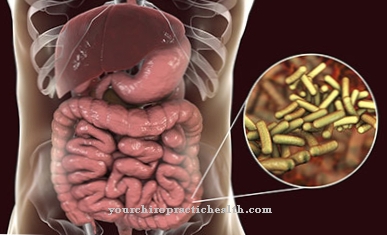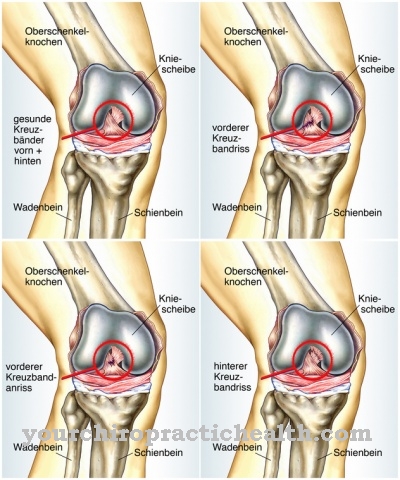As part of a Trochlear palsy a lesion of the 4th cranial nerve occurs, as a result of which paralysis of the upper eye muscle occurs. Trochlear palsy can occur either unilaterally or bilaterally or completely or partially.
What is Trochlear Palsy?
The fourth cranial nerve originates in the midbrain and is the only cranial nerve to cross completely to the opposite side below the so-called four-hill plate. It is a purely somatomotor nerve and supplies the oblique, upper eye muscle, also known as Superior oblique muscle referred to as. A contraction of this muscle triggers a downward eye movement. The trochlear nerve is the smallest oculomotor cranial nerve, its paralysis to one Trochlear palsy leads. If the IV cranial nerve fails, eye movements are restricted or a typical squint pattern occurs. Of all the cranial nerves that is Trochlear nerve seldom affected by symptoms of paralysis, the most common cause being traumatic brain injuries.causes
Trochlear palsy occurs as a result of strokes, microangiopathies, aneurysms, or traumatic brain injuries. The trochlear nerves are particularly often affected in head trauma. Mucormycosis or cysticercosis are possible inflammatory causes, but trochlear palsy can also be caused by tumors in the region of the upper brain stem (chardoma, metastases, lymphomas, gliomas).
However, these are usually accompanied by other symptoms. Trochlear paresis can also occur with hypertension or diabetes mellitus, in which case the prognosis is very favorable. Other possible causes of trochlear palsy can be:
- Tolosa Hunt Syndrome
- Complications in neurosurgical operations
- multiple sclerosis
- meningitis
There are also congenital trochlear palsy or those that are acquired in early childhood. These then show different symptoms. The cause of congenital or early acquired trochlear palsy is not yet known. Birth trauma could play an essential role here. Congenital trochlear palsy should always be differentiated from so-called strabismus sursoadductarius (congenital squint position of the oblique eye muscles).
It is also necessary to consider a possible injury to the cartilage (trochlea) in the event of post-traumatic disorders of the upper eye muscle. In addition, a torticollis spasticum (torticollis) or a dissociated vertical squint should be excluded.
Symptoms, ailments & signs
If trochlear palsy occurs, the affected muscle loses its function. The oblique upper eye muscle usually fulfills three different tasks: an outward turning, an inward rolling and a lowering one. In the case of trochlear palsy, however, the view deviates, that is, a squint or a roll in the direction of the temple occurs.
In addition, those affected see double images that are perceived either tilted, vertically or horizontally. As a result, the patients assume a forced head position in order to be able to eliminate the double vision. Most of the time the head is tilted to the healthy side, but if the head is tilted towards the diseased side, the eye can be seen to be raised. This phenomenon is known as the so-called “Bielschowsky phenomenon”.
Trochlear palsy is extremely annoying, especially when it comes to everyday things such as eating, reading or working on a desk, where the gaze is directed downwards. Accidents can also occur when climbing stairs or walking, as the squint angle cannot be compensated for with the help of a forced head posture. Another symptom is the difference between the primary and secondary squint angles.
The primary angle is the squint deviation that can be measured with the non-diseased eye during fixation. The secondary angle describes the deviation during fixation with the respective affected eye. If a paralysis strabismus occurs, the primary angle is always smaller than the secondary angle. In the case of a trochlear palsy that occurs on both sides, however, it may well be that a squint deviation is missing when looking up.
Diagnosis & course of disease
Trochlear palsy is diagnosed by a neurologist. This measures the squint angle in different viewing directions and with different fixations. In addition, the monocular excursion skills as well as the field of binocular simple vision are assessed. The synoptometer or the Harms tangent table are used for the investigation.
The Bielschowsky head tilt test also provides further information about the presence of trochlear palsy. If the head is tilted towards the diseased side, a higher position of the affected eye can be seen, but on the healthy side there is no strabismus deviation or it is considerably reduced. In the case of spontaneous trochlear palsy, a tensilon or glucose tolerance test and an orbital MRI are carried out to rule out myasthenia. Trochlear palsy is often recognized relatively late because it is often fairly normal or the symptoms are misinterpreted.
Complications
Trochlear palsy leads to various symptoms of the eyes. Those affected suffer from double vision or veiled vision, which leads to significant restrictions in the everyday life of the person concerned. In many cases, patients have to hold their head in a forced position so that it is tilted to one side.
This attitude can lead to severe discomfort and restrictions in everyday life. Accidents can occur, especially when running. The disease can also promote strabismus. The affected person can often no longer look up. Especially in children, trochlear palsy can lead to bullying or teasing due to poor posture.
As a result, many children also suffer from psychological complaints or depression. However, the disease leads to restrictions in child development, so that complications and complaints can also arise in adulthood. The treatment of trochlear palsy is usually carried out at a very early age and in most cases is successful. There are no complications. Usually the complaints are completely resolved.
When should you go to the doctor?
An immediate visit to a neurologist is advisable in the case of sudden visual disturbances with strabismus and double vision. It may be a trochlear palsy that needs treatment. Above all, however, the cause must be determined. An ophthalmologist is often called in to diagnose this disorder.
Many patients first try to compensate for the typical symptoms of trochlear palsy by changing head positions. Instead, because of the drama of possible triggers, they should go straight to a neurologist or ophthalmologist. Trochlear palsy can occur as a result of a traumatic brain injury, micro-angiopathy, aneurysm, stroke, or inflammatory processes. In all cases it is strongly advised to start treatment as soon as possible.
Careful differential diagnostics and anamnesis ensure that the cause of the phenomenon is identified and, if possible, treated successfully. At the same time, attempts are being made to improve the symptoms of trochlear palsy. This can be done through prism glasses or an operation. Whether or not the paralysis of the upper eye muscle goes away completely after this treatment varies.
Trochlear palsy is often an idiopathic symptomatology that cannot be determined in terms of the causes. Few triggers have been identified so far. Other triggers that can lead to trochlear palsy have not yet been discovered. There are congenital palsy or trochlear palsy in small children. However, these have different symptoms.
Therapy & Treatment
The squint deviation can be improved with the help of prism lenses. If the paralysis does not resolve after six to nine months, an operation is necessary in order to be able to reduce the forced head posture or the cyclotropia. Muscle-strengthening interventions in which the affected eye muscle is folded or positioned in front are also effective.
A restoration of the function can usually only be assessed after six to twelve months. Therefore, an operation is usually only considered after one year. During this time, the lower part of the lens is also often covered in order to avoid annoying double images. Treatment with botulinum toxin is also possible to weaken the antagonistic muscle.
You can find your medication here
➔ Medicines for eye infectionsprevention
Since trochlear palsy can occur as a result of a stroke or head trauma, it is not possible to prevent the lesion.
Aftercare
After treating trochlear palsy, those affected should undergo special visual training. In addition, regular examinations should be performed by the attending doctor. To avoid recurrence, the ophthalmologist must monitor the eyesight of those affected and, if necessary, prescribe further medication.
Those affected should list all symptoms in a diary and present them to the treating doctor so that the doctor can act in good time. Physiotherapy should also be started because of the constrained posture. Those affected should take great care of their social environment so that the help of relatives, for example, can be called upon at any time. After the final treatment, sufferers can also use natural medicine painkillers in consultation with the attending physician.
Since the disease can be a serious burden for many people affected and their relatives, it is recommended to undergo permanent psychological counseling. In this way, those affected and their relatives can learn how to deal with the disease. In order to increase their quality of life again, those affected should pursue activities that they enjoyed before the illness. The social environment also plays a major role here. A self-help group can also be beneficial. In this way, those affected can exchange ideas with other sick people and compare their lifestyles.
You can do that yourself
The trochlear palsy can possibly be corrected with special prism lenses. If necessary, an operation must also be performed. People can take various measures to help with treatment.
First of all, targeted eye training and regular visits to the doctor are recommended. The ophthalmologist must monitor the eyesight and, if necessary, prescribe additional medication to prevent the condition from worsening. In the case of congenital trochlear palsy, it is also necessary to differentiate it from other diseases with similar symptoms. Those affected should therefore keep a complaint diary and write down the various symptoms in detail. The information can then be used for diagnosis. The forced head posture can be corrected through targeted physiotherapy. In addition, pain medication must be used.
In consultation with the doctor, gentle painkillers from naturopathy can be used, especially after the therapy has ended. There are, for example, preparations with valerian or St. John's wort, as these can be taken together with normal medication due to the low side effects. If these measures are followed, trochlear palsy can be treated well. In any case, however, close medical monitoring of the person concerned is necessary.

.jpg)











.jpg)

.jpg)
.jpg)











.jpg)